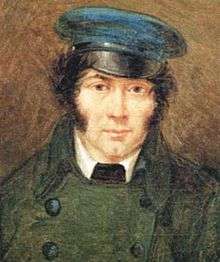Francesco Caracciolo

Prince Francesco Caracciolo (18 January 1752 – 30 June 1799) was a Neapolitan admiral and revolutionist.
Early life and British service
Caracciolo was born in Naples to a noble family. It is likely that he was named after St. Francis Caracciolo, a saint of the Catholic Church and Francesco's many times great uncle. He entered the navy and learned his seamanship under Rodney. He fought with distinction in the British service in the American War of Independence, against the Barbary pirates, and against the French at Genoa under Lord Hotham. The Bourbons placed the greatest confidence in his skill.
To Sicily and back
When on the approach of the French to Naples, King Ferdinand IV and Queen Mary Caroline fled to Sicily on board Horatio Nelson's ship, HMS Vanguard (December 1798), Caracciolo escorted them on the frigate Sannita. He was the only prominent Neapolitan trusted by the king, but the admiral's loyalty was shaken by Ferdinand's flight. On reaching Palermo, Caracciolo asked permission to return to Naples to look after his own private affairs (January 1799). This was granted, but when he arrived at Naples he found all the aristocracy and educated middle classes infatuated with the French revolutionary ideas, and he himself was received with great enthusiasm.
Republican service and capture
He seems at first to have intended to live a retired life; but, finding that he must either join the Republican party or escape to Procida, then in the hands of the English, in which case even his intimates would regard him as a traitor and his property would have been confiscated, he was induced to adhere to the new order of things and took command of the republic's naval forces. Once at sea, he fought actively against the British and Neapolitan squadrons and prevented the landing of some Royalist bands. A few days later, all the French troops in Naples, except 500 men, were recalled to the north of Italy.
Caracciolo then attacked Admiral Thurn, who from the Minerva commanded the Royalist fleet, and did some damage to that vessel. But the British fleet on the one hand and Cardinal Fabrizio Ruffo's army on the other made resistance impossible. The Republicans and the 500 French had retired to the castles, and Caracciolo landed and tried to escape in disguise. He was betrayed and arrested by a Royalist officer, who on 29 June brought him in chains on board Nelson's flagship, HMS Foudroyant.
Trial and execution
It is doubtful whether Caracciolo should have been included in the capitulation concluded with the Republicans in the castles, as that document promised life and liberty to those who surrendered before the blockade of the forts, whereas he was arrested afterwards, but as the whole capitulation was violated, the point is immaterial. Moreover, the admiral's fate was decided even before his capture, because on 27 June, the British minister, Sir William Hamilton, had communicated to Nelson, Queen Mary Caroline's wish that Caracciolo should be hanged. As soon as he was brought on board, Nelson ordered Thurn to summon a court martial composed of Caracciolo's former officers, Thurn himself being a personal enemy of the accused. The court was held on board the Foudroyant, which was British territory—a most indefensible proceeding.
Caracciolo was charged with high treason; he had asked to be judged by British officers, which was refused, nor was he allowed to summon witnesses in his defence. He was condemned to death by three votes to two, and as soon as the sentence was communicated to Nelson, the latter ordered that he should be hanged at the yard-arm of the Minerva the next morning, and his body thrown into the sea at sundown. Even the customary twenty-four hours respite for confession was denied him, and his request to be shot instead of hanged refused. The sentence was duly carried out on 30 June 1799.
The local port of St. Lucia nevertheless took care of Caracciolo's remains, giving him a proper funeral and burial at church of Santa Maria della Catena. His epitaph reads, Francesco Caracciolo, Admiral of the Republic of Naples, who fell victim of the hatred and the lack of mercy of his enemies. He was hanged at the mast on 29 June 1799. The people of Santa Lucia took it upon themselves to honour him with a Christian burial. The City Council of Naples, 1881.
![]() This article incorporates text from a publication now in the public domain: Chisholm, Hugh, ed. (1911). "Caracciolo, Francesco". Encyclopædia Britannica (11th ed.). Cambridge University Press.
This article incorporates text from a publication now in the public domain: Chisholm, Hugh, ed. (1911). "Caracciolo, Francesco". Encyclopædia Britannica (11th ed.). Cambridge University Press.